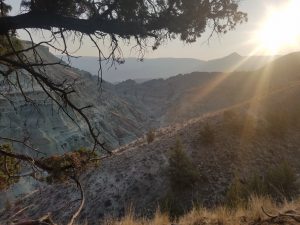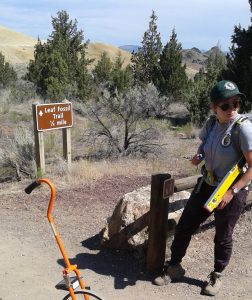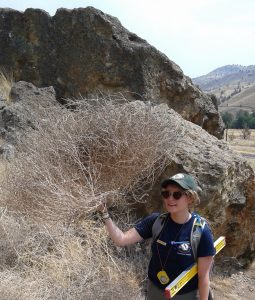October 15, 2018
Interning for the National Park Service through “Geoscientists-in-the-Parks”
Posted by AGU Career Center
What do saber-tooth tigers, sheep ranches, sagebrush, and supervolcanoes have in common? They’re all in eastern Oregon! A former “Geoscientist-in-the-Park” writes about her time as an interpretive intern at the John Day Fossil Beds National Monument this past summer.

Sunrise over the John Day Fossil Beds.
The John Day Basin is dry, remote, and starkly beautiful. Over 50 million years of geology is recorded in the rugged mountains of the region, providing a glimpse into the tumultuous history of ancient North America. Entombed within these brightly colored rocks is an incredibly diverse assemblage of fossils that paint a detailed picture of climate change and evolution in the Cenozoic. No place on the planet has such a biodiverse, continuous, and radiometrically datable fossil record as the John Day Fossil Beds.
It’s a neat place for a geologist to poke around.
It also gets hot enough to melt your shoes sometimes, but I digress.
This past May I graduated with a geology degree from Lafayette College, a small liberal arts college in eastern Pennsylvania. While many of my fellow graduates traveled to new jobs in cities like New York City or Philadelphia, my first move was to pack up my belongings and drive cross country to spend a summer in a town of 150 people in the desert. I was a participant in the “Geoscientists-in-the-Parks” (GIP) program, an internship supported by the National Park Service, GSA, and AmeriCorps that provides science undergraduates and graduates 18-35 years old the opportunity of a lifetime: to live and work in a National Park. As an AmeriCorps Program, participants also earn an education award upon completion of their service.
Geoscientists-in-the-Parks
GIPs spend their time doing anything from presenting astronomy programs to conducting hydrologic surveys, depending on the needs of their park. As a GIP at the John Day Fossil Beds, I spent half of my time being what one would classically think of as a park ranger, while using the other half to work on projects improving accessibility within the park.

Surveying for ADA accessibility standards at the Painted Hills (photo by Stephen Morioka).
Public Lands are intended for all the American people to enjoy. However, rocky and narrow trails, and inaccessible structures inhibit people with disabilities from fully experiencing parks. Most trails in local, state, and national parks were built long ago, and were not designed with accessibility in mind. For a trail to be designated as accessible, it must adhere to strict standards from the ABA. For example, if at any point the width of a path falls below 36”, it cannot legally be considered accessible. My fellow intern and I surveyed every trail in the John Day Fossil Beds, so that changes can be made to make these recreational areas available to more people in the future.
Odds are if you’ve visited a national park you’ve interacted with a Park Ranger, but what do they really do? Many are interpreters. Interpretive Park Rangers don’t interpret languages (although many can!), rather they work to convey the natural, historic, and cultural significance of the public lands, inspiring visitors to care about them. Parks are only protected so long as people understand their value, and in this current political climate, I believe it is more important than ever to convey the significance of national parks.
As a ranger at the John Day Fossil Beds, my typical day involved anything from giving a talk at the visitor center, leading a guided hike, to periodically assessing if dogs can recognize fossils of their canine ancestors (current hypothesis: maybe?). Honestly, I didn’t come to the John Day Fossil Beds out of a love of fossils, and despite the mind-blowing fossil finds I witnessed this summer, I still don’t aspire to be a paleontologist. But if that’s your vibe, consider applying for this program! I do like a good story though, and with over fifty million years of geologic history to work with, I challenge you to get bored.
So, what kind of skills do you need to be a park ranger?
Park Rangers come from diverse educational backgrounds, but scientists bring a unique skill set to the table. As a scientifically literate person, you can directly translate the latest relevant research to a general audience. This summer I learned a few key lessons that helped me improve my communication skills in an informal education context:

Photo evidence of my first time seeing a tumbleweed, 10/10 great tumbleweed experience (Photo by Stephen Morioka).
- Fail, a lot: One of the most important values in science is being able to learn from your failures, and behind every perfect experiment are countless attempts to optimize the results. As an interpreter, you can think about any presentation you give as a trial, working to continually fine-tune your technique. You can use this opportunity to experiment with different activities, or talk about different topics, or workshop a joke or two. If something doesn’t turn out the way you like, simply change it the next time.
- Connect with your audience: If people know about you, they’ll care about what you’re talking about. Interpretation isn’t one-sided either, you can make it an exchange. Don’t ask people their social security numbers or anything, but think of universal questions that can inspire a dialogue. Then finally, use that dialogue to transition to your subject matter. For example, if we’re talking about the ways that geologists measure time (i.e. radiometric dating, biostratigraphy, etc.), I might first ask, how do you measure time in your own life? Personal experiences can provide an unlikely perspective for understanding seemingly-abstruse scientific concepts.
- Inform, but don’t inundate: As an interpreter, you’re not teaching a class. There isn’t a test. Your success isn’t measured by providing people with a complete knowledge of everything in your comprehensive scientific repertoire. Rather, its measured by whether you’ve piqued their interest. You want to inspire them to learn more, to ask questions, not to run far away. Instead of trying to tell everyone everything, learn how to make your points in small, digestible vignettes.
- Observe and adapt: People have a variety of interests. Something that is incredibly compelling from your perspective, might not be compelling for your audience. Take note of nonverbal cues especially, what do people find captivating? For any interaction, you’ll need to tailor both your content and communication style to your audience. One minute, you might be speaking with a college professor, while the next you’re interacting with a 4-year-old who doesn’t speak English. You need to be agile.
Working as a park ranger is an incredible opportunity to directly engage the public in science, and regardless of if you’re looking to work as an interpreter with the NPS, honing your science communication ability is a worthwhile endeavor. As a whole the Geoscientists- in-the-Park program provides a unique learning experience for graduates by providing an opportunity to serve the community, share science with a wide audience, and explore career paths in the federal government. If this program sounds like something you’re interested in, applications for summer positions open in December 2018.
Mary (Lissie) Connors, Fall 2018 Talent Pool Intern, American Geophysical Union


 On the Job is an AGU blog, that provides career advice and workforce guidance to geoscience students, early-career and established professionals who are interested in pursuing professional enrichment.
On the Job is an AGU blog, that provides career advice and workforce guidance to geoscience students, early-career and established professionals who are interested in pursuing professional enrichment.
Well written and insightful. You’ll do well!